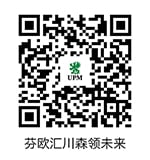In recent years UPM has made major investments in order to streamline its pulp production and increase its production capacity in both Finland and Uruguay. As a result, the company’s annual pulp production capacity will reach 3.7 million tonnes in 2017. UPM’s overall pulp capacity has grown by more than 500,000 tonnes since 2013.

Anssi Klinga
Two thirds of this pulp is sold to customers around the world, mainly in Europe and China, with UPM’s own paper businesses purchasing approximately one third. “The long-term outlook for the global pulp market is excellent, as several megatrends will increase pulp demand in the long run. We have carried out carefully targeted investments at all of our mills in order to increase production capacity as cost-efficiently as possible,” says Anssi Klinga, Senior Vice President at UPM Pulp.
Upgrades have been made at the Pietarsaari, Kymi and Kaukas mills in Finland and the Fray Bentos mill in Uruguay. Last year a new pulp drying machine was completed at the Kymi mill. With this added drying capacity, the Kymi mill has been able to increase its annual pulp production by more than 170,000 tonnes. In July, UPM announced further production expansion at Kymi mill to be completed by the end of 2017. “We have successfully expanded our pulp production capacity by a total of 500,000 tonnes in recent years, which is equivalent to the entire annual output of a medium-sized pulp mill,” Klinga explains.
Continuous improvements are also being made to production processes. “We have focused on employee competence and mill maintenance and achieved excellent results in these areas,” Klinga says.
Market to grow 2.5% per year
Consulting company Pöyry estimates that the global demand for bleached chemical market pulp will grow by approximately 2.5% per year for the next ten years. This trend is supported by global megatrends, first and foremost urbanization and the increasing purchasing power of consumers.
“The disposable income of the middle class is growing, particularly in emerging markets. This will increase the demand for pulp-based products,” says Petri Jokinen, Senior Principal at Pöyry Management Consulting.
A rapidly growing product group are tissue products such as toilet paper, facial tissue, hand towels and paper handkerchiefs. The demand for pulp-based board and other packaging materials is also growing. “The lifestyle of the increasingly wealthy middle class is becoming more westernized. Instead of buying products from traditional outdoor markets, consumers increasingly buy packaged products at supermarkets,” Jokinen describes. The rapid growth of e-commerce will also push demand for packaging materials.
China already accounts for approximately one third of global pulp consumption. According to Jokinen, the recent deceleration of China’s economic growth will not have the same effect on pulp as it will on the demand for metals and other capital goods. “In China, the focus of the economy is shifting from investment to household consumption. This means that the demand for packaging and personal care products will grow.”
Jokinen expects the Chinese pulp market to remain on a growth track for a long time. “It will take decades before the country’s standard of living is at the western level. Indonesia, Vietnam and India are also becoming more affluent. The expansion of the pulp market will continue for several decades in these countries.”
Less recycled fibre, more pulp
Reduced consumption of printing papers does not reduce the demand for pulp. “In fact, the demand for pulp may even increase,” Klinga says. When the amount of available printing paper decreases, there will be less recycled fibre available, and hence more need for pulp.
UPM’s recent investments will further strengthen the company’s position as an international pulp market leader, says Klinga. “A growing volume of pulp is needed for products that are manufactured close to consumers.” Pulp bales are the most cost-efficient solution for transporting raw material. The majority of the pulp that UPM sells in China arrives in bales from the Fray Bentos mill in Uruguay. China lacks sufficient raw materials to cover its growing pulp demand, which means that pulp imports will continue in the future.
Klinga believes that the range of pulp-based products will also expand in the future. Pulp based materials can be used to replace oil-based plastics, for instance. Pulp is also used in biomedical innovations such as UPM’s GrowDex® hydrogel, which is used for cell culturing in laboratory environments.
Matti Remes
Read more
